Aaron's Expert Center - Fungus
problems
|
|
|
Light
disease damage-High
heat and traffic contribute to stressful conditions, making fungus
more evident. |
Moderate
damage-Most of the time damage will fill in without
long term damage. Organic fertilizer steps help suppress this
level of damage. Note-lawn mowing has aggrivated and spread fungus
damage. |
Severe
damage-This needs to be stopped with a fungicide.
Organic fertilizer along with soil conditioning services, aeration
and new, more disease tolerent cultivars (grass) will reduce future
damage. |
Summer Patch, Necrotic
Ring Spot, and Brown Patch are root born diseases that make
circles and frog eye shapes. Almost every lawn has had or does
have these problems. These diseases are most evident in times
of stress, like when it's dry and hot. Conditions such
as excessive thatch, poor soil, sod installed over a poorly
prepared site and poor cultural practices (mowing and watering)
can give these fungus problems all they will need to do serious
damage. In most cases, light to moderately damaged
areas will recover with minimum long term damage. In severe
cases, Fungicide treatments may be needed to stop the damage
from getting any worse and rescue the rest of the lawn from
infection. Treating light to moderately damaged lawns with a
special organic fertilizer and aeration supresses disease by
balancing out soil problems naturally, and is a very cost effective
and environmentally friendly long term option.
|
If
you have any questions that are not covered in this section please
call (815)282-2766 for more detailed information. |
|
| |
Fungus Problems
There are many different
types of fungus which grow in every lawn and it's unlikely that
you could eliminate all disease causing fungi, and you wouldn't
want to if you could. Many of the fungi that cause turf grass
diseases are also important in nutrient cycling, especially in
breakdown of thatch. However, if cultural conditions deteriorate
these "beneficial" pathogens can cause serious problems. |
Problematic
Fungus:
What is it?
There
are several problematic types of fungus in our area. Some of the
most common types include Summer Patch, Necrotic Ring Spot, and
Brown patch. The damaged areas can appear as sunken spots of yellow
turf that make patches or circles which are sometimes referred
to as "frog eye". Damage can be aggravated with stress
which can occur in many forms such as the wheels from the mower,
which can leave what appear to be tracks of yellow turf behind
a few days after it occurs. |
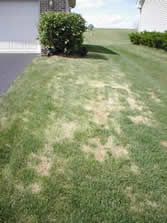 Summer Patch / Cut to Short - Treat
with an Organic Fertilizer
Summer Patch / Cut to Short - Treat
with an Organic Fertilizer |
In
the past Summer Patch and Necrotic Ring Spot were referred to
as Fusarium Blight, however, recent research has led to the reclassification
of these notorious types of lawn diseases. |
Summer Patch:
Summer
Patch is caused by the soil-borne fungus called Mangaporthe Poae.
It is commonly associated with grasslands and appears mostly in
Bluegrass and Fine Fescue grasses, but can show up in other types
of cool season grasses as well. It is a warm weather root disease
and grows best in temps between 80-85 degrees Fh and can occur
in turf from mid-June through September and reappears during times
of hot weather. |
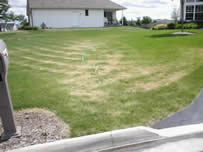 Tracks from mower due to fungus
stress
Tracks from mower due to fungus
stress |
Summer
patch’s straw-brown splotches range from 6 inches to as
much as 3 feet wide growing as the fungus infected areas age.
Young roots may appear healthy during early stages of the disease,
but will later show signs of discoloration and rot. Summer Patch
moves from plant to plant creeping along roots and rhizomes and
spreading at a rate of around 1 ½ inches per week. Recently
effected plants on the outer edge of the patch are often a distinct
orange or bronze color and patches can even appear more bluish-green.
The color is what makes summer patch hard to identify because
most people don’t notice it until infected plants begin
to die. |
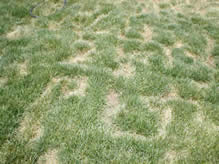 Severe fungus damage needs to be
stopped with a fungicide
Severe fungus damage needs to be
stopped with a fungicide |
Necrotic
Ring Spot:
Necrotic
Ring Spot is caused by the Leptosphaeria korrae fungus and it
is a cool weather root disease. Symptoms are nearly identical
to summer patch, however, in contrast to summer patch Necrotic
Ring Spot kills roots in the late spring when soil temps reach
65 degrees and continues through the summer with symptoms appearing
in late June and July.
Brown Patch:
Brown
Patch is caused by fungus named Rhizactonia solani. It is active
mostly in warm temperatures and symptoms begin to show under these
conditions. |
| |
In Summary:
These
"patch diseases" are similar in appearance and management
and will likely return to the same areas of the lawn every year.
Unless steps are taken to change the conditions in the lawn which
lead to the propagation of these diseases they will rapidly spread.
For even more detailed information please visit the University
of Illinois Extension.
|
Fungus Prevention:
Once
damage has occurred these fungus problems are extremely difficult to
control. Preventative maintenence and application of proper cultural
practices are the best way to manage these types of lawn diseases.
Preventative
Maintenence:
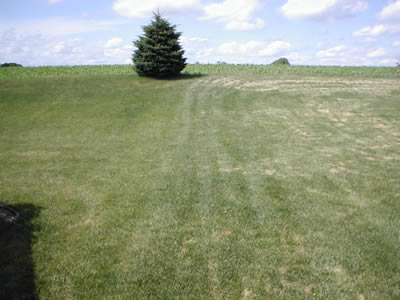
Side
by side: on the
left results with an organic
granular time-release fertilizer, on the
right results with a standard
granular time-release fertilizer |
|
Organic
Fertilizer:
By
looking at the picture above, the results speak for themselves.
Both yards are fertilized with Granular Time-Release Fertilizer,
However, the yard on the left is fertilzed with Organic Granular
Time-Release Fertilzer. Soil is more important to the overall
health of your lawn than any other variable. It has been proven
time and again that organics supress fungus and
stimulate healthy micro-organisms. By accelerating and
stimulating microbial life (the life blood of rich soil), you
can reduce thatch maintenance, increase drought tolerance,
and insure better long term health. Getting your soil closer to
the optimum organic state will make a lasting difference. |
|
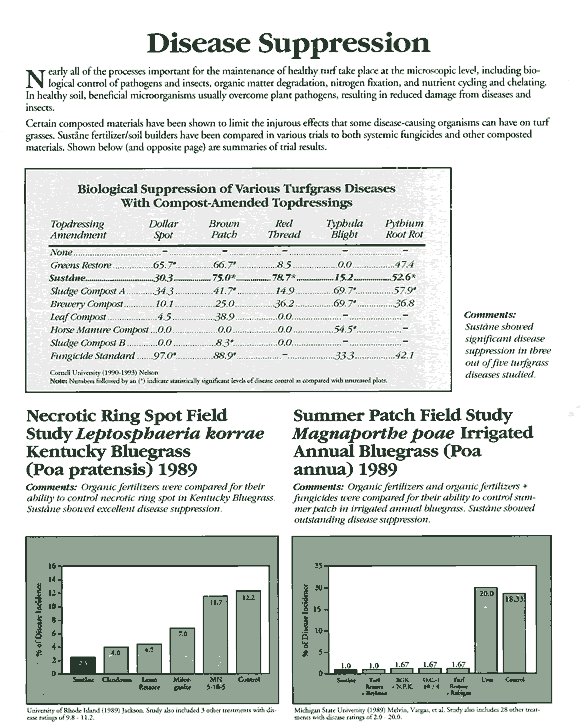
WOULD
YOU LIKE TO RECEIVE A FREE ESTIMATE?
Proper Cultural
Practices:
The term
"cultural practices" refers to the way you maintain your lawn.
Your turf should be maintained in a vigorous but not in a over stimulated
growing condition. Any factor that inhibits root growth will increase
likelihood of turf disease.
Some key factors which can help
maintain proper cultural conditions include:
|
|
Avoid
liquid or quick release high nitrogen fertilizers! |
|
|
|
|
|
|
Additional Information:
Maintaining Proper pH Levels:
Fungus Disease
is most severe in soils with a pH above 6.5. To prevent this disease
in turf, first conduct a soil test to find out what the pH is on your
lawn. Then based on what is found in your soil test either sulfer (to
lower the pH) or granular lime (to raise the pH) may be recommended
to correct the pH of your soil.
Sod which has been recently (2-5
years) applied onto poorly prepared soil:
Improperly applied sod
can lead to poor root penetration.(Examples: rocky soil, heavily compacted
soil, clay based soil) Sod also comes with a heavy thatch layer which
can hold moisture in and doesn't allow for proper air circulation.)
Was your question not covered
in the Expert Center?
Well, then Ask Aaron!
|
|



